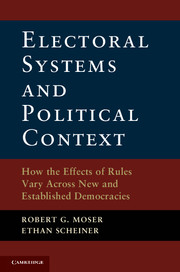 Electoral Systems and Political Context
Electoral Systems and Political Context Book contents
- Frontmatter
- Contents
- Tables and Figures
- Abbreviations
- Glossary of Key Terms
- Acknowledgments and Note on the Online Appendix
- Introduction
- 1 When Do the Effects of Electoral Systems Diverge from Our Expectations?
- 2 Mixed-Member Electoral Systems
- 3 How Democratic Experience and Party System Development Condition the Effects of Electoral Rules on Disproportionality and the Number of Parties
- 4 How Democratic Experience and Party System Development Condition the Effects of Electoral Rules on Disproportionality and the Number of Parties
- 5 Political Context, Electoral Rules, and Their Effects on Strategic and Personal Voting
- 6 How Democratic Experience and Party System Development Condition the Effect of Electoral Rules on Strategic Defection
- 7 Social Diversity, Electoral Rules, and the Number of Parties
- 8 How Political Context Shapes the Effect of Electoral Rules on Women's Representation
- 9 Conclusion
- References
- Index
7 - Social Diversity, Electoral Rules, and the Number of Parties
Published online by Cambridge University Press: 05 November 2012
- Frontmatter
- Contents
- Tables and Figures
- Abbreviations
- Glossary of Key Terms
- Acknowledgments and Note on the Online Appendix
- Introduction
- 1 When Do the Effects of Electoral Systems Diverge from Our Expectations?
- 2 Mixed-Member Electoral Systems
- 3 How Democratic Experience and Party System Development Condition the Effects of Electoral Rules on Disproportionality and the Number of Parties
- 4 How Democratic Experience and Party System Development Condition the Effects of Electoral Rules on Disproportionality and the Number of Parties
- 5 Political Context, Electoral Rules, and Their Effects on Strategic and Personal Voting
- 6 How Democratic Experience and Party System Development Condition the Effect of Electoral Rules on Strategic Defection
- 7 Social Diversity, Electoral Rules, and the Number of Parties
- 8 How Political Context Shapes the Effect of Electoral Rules on Women's Representation
- 9 Conclusion
- References
- Index
Summary
Thus far, this book has focused on the interactive effect on political outcomes of electoral rules and the level of democratic and party system development. In this chapter, we shift our focus to how electoral rules interact with a different category of political context, social diversity, to affect the party system.
A long line of research has argued that the number of parties in a country is the product of an interactive process between the number of social cleavages and the electoral system, whereby social heterogeneity has little effect on the number of parties under “restrictive” rules such as first-past-the-post (Duverger 1954; Ordeshook and Shvetsova 1994; Amorim Neto and Cox 1997; Clark and Golder 2006; Singer and Stephenson 2009). Many scholars posit that as the number of distinct groups in society increases, so will the number of parties, but that this relationship will exist only under “permissive” electoral rules (such as PR with high district magnitude and little or no legal threshold of representation). The incentives of the electoral system under restrictive rules drive voters, groups, and elites to withdraw their support from candidates who are unlikely to be competitive, and instead line up only behind those truly “in the running” – thereby leading to a small number of parties (or candidates), irrespective of the number of distinct groups in society.
- Type
- Chapter
- Information
- Electoral Systems and Political ContextHow the Effects of Rules Vary Across New and Established Democracies, pp. 180 - 207Publisher: Cambridge University PressPrint publication year: 2012


